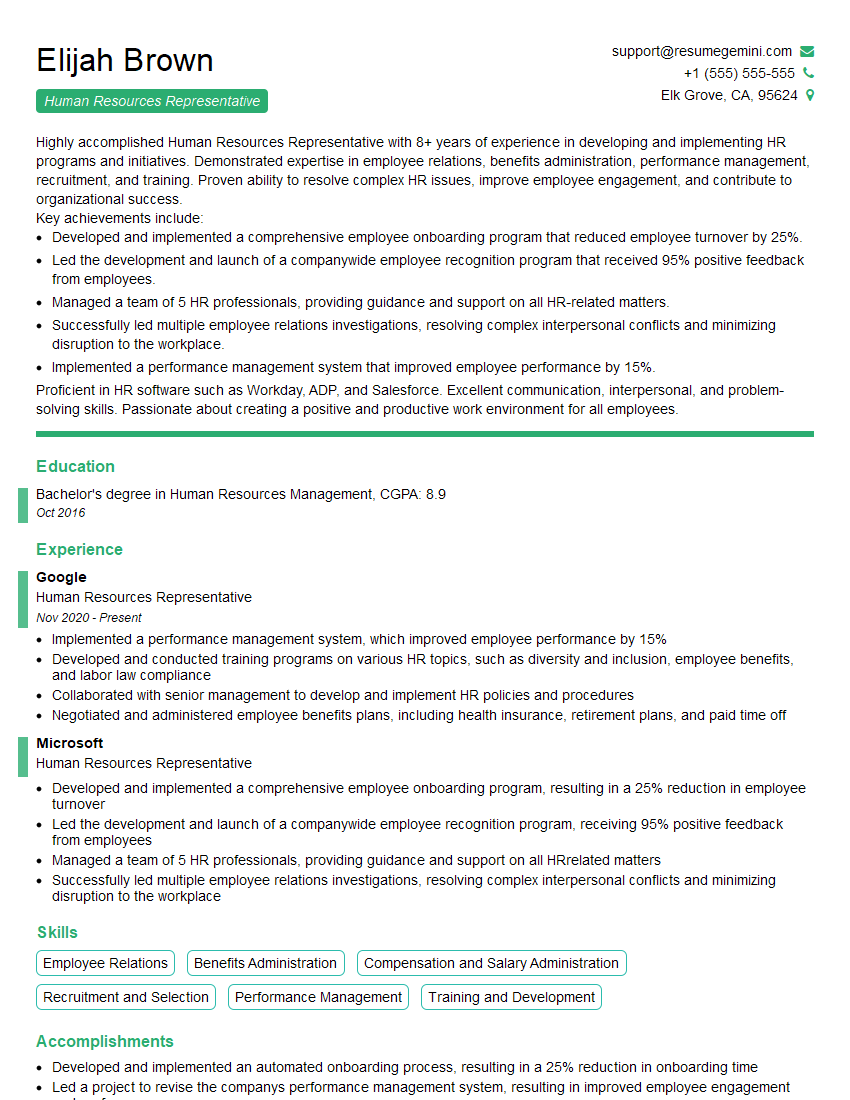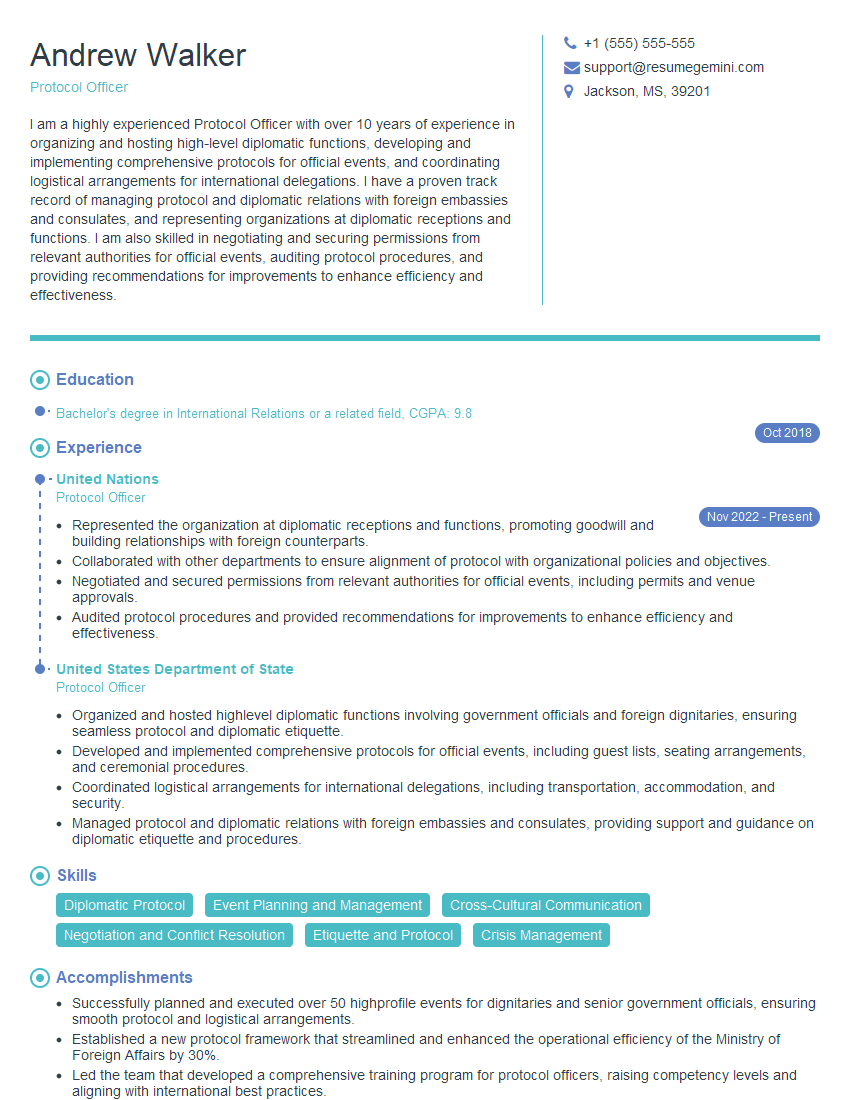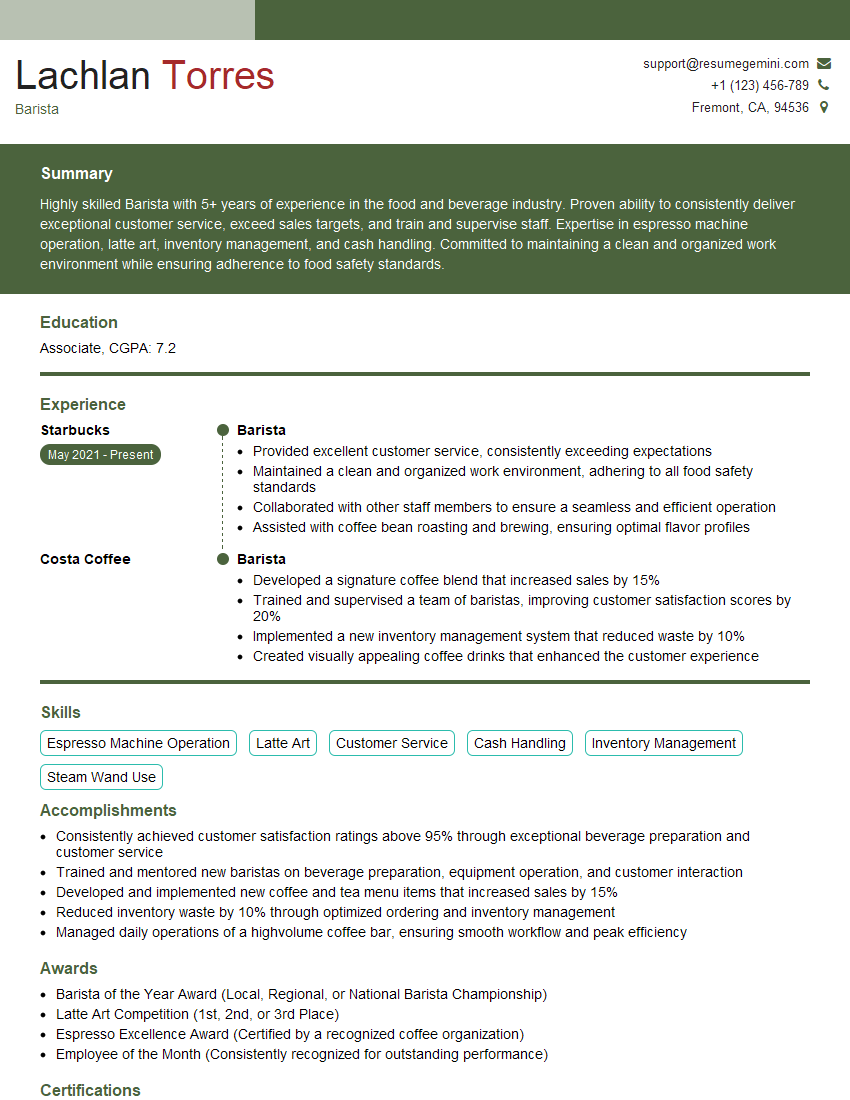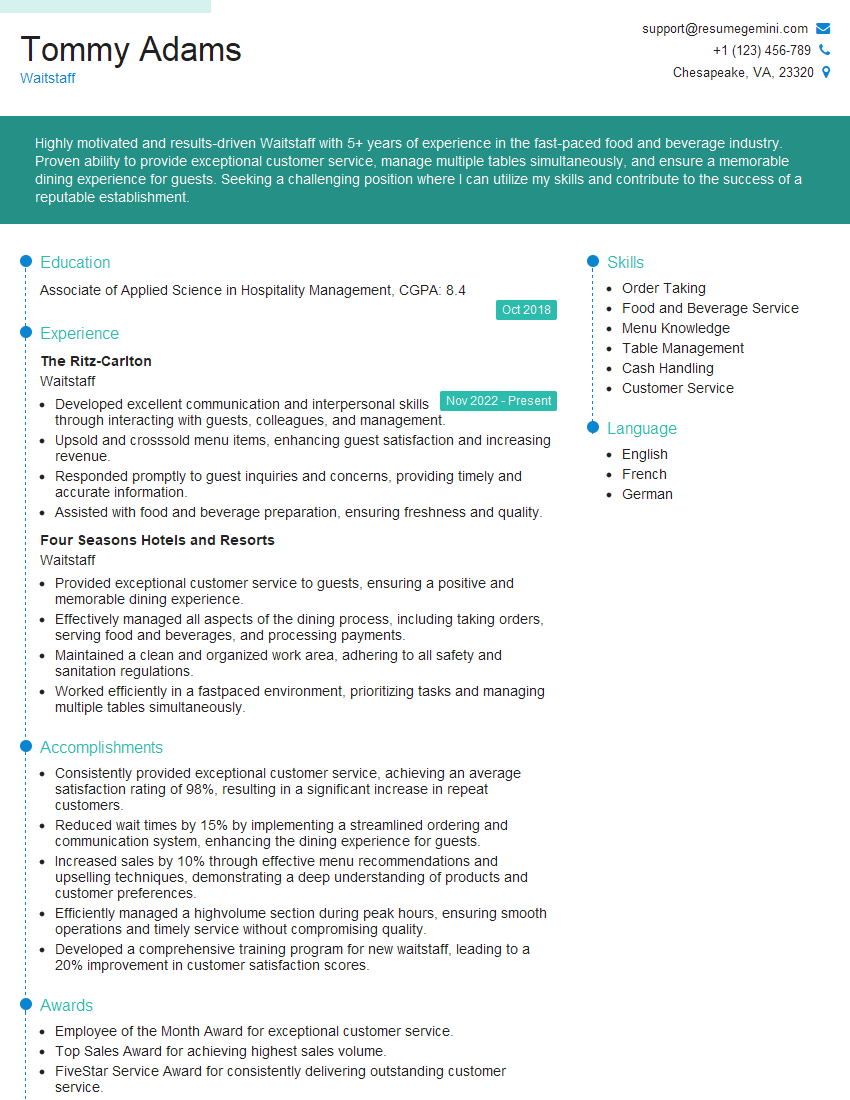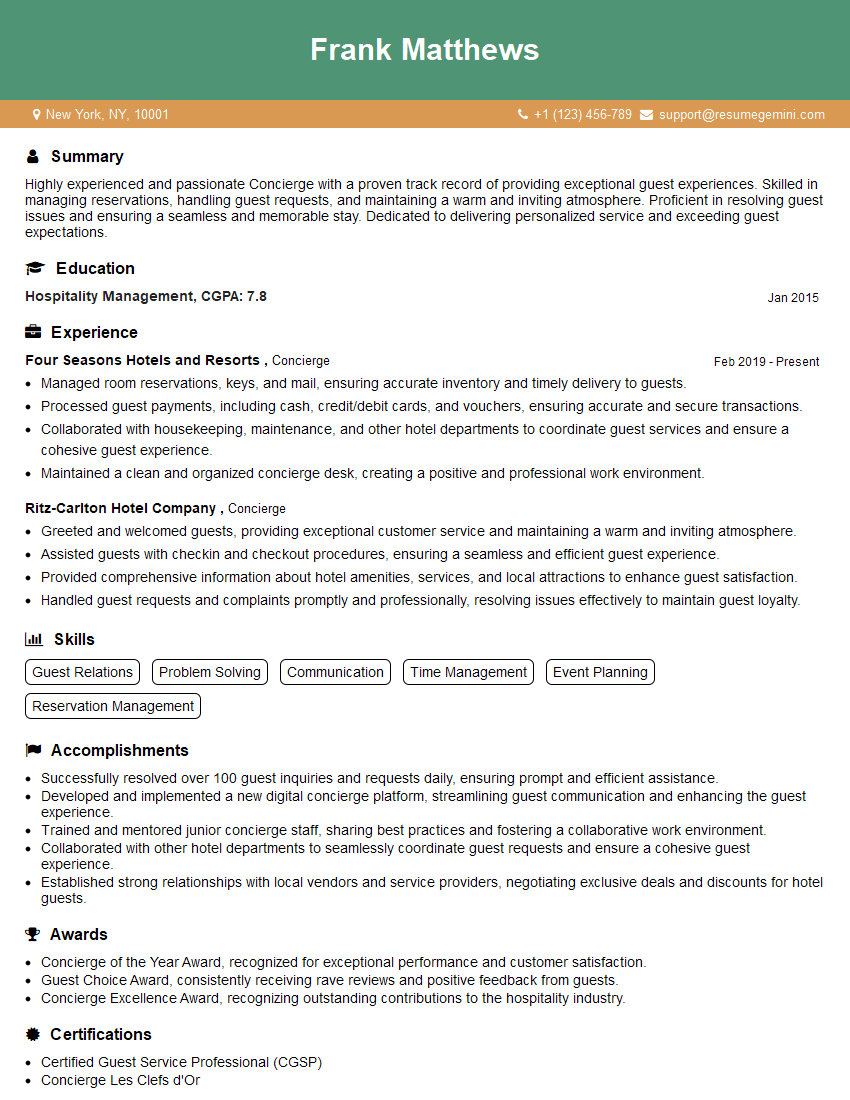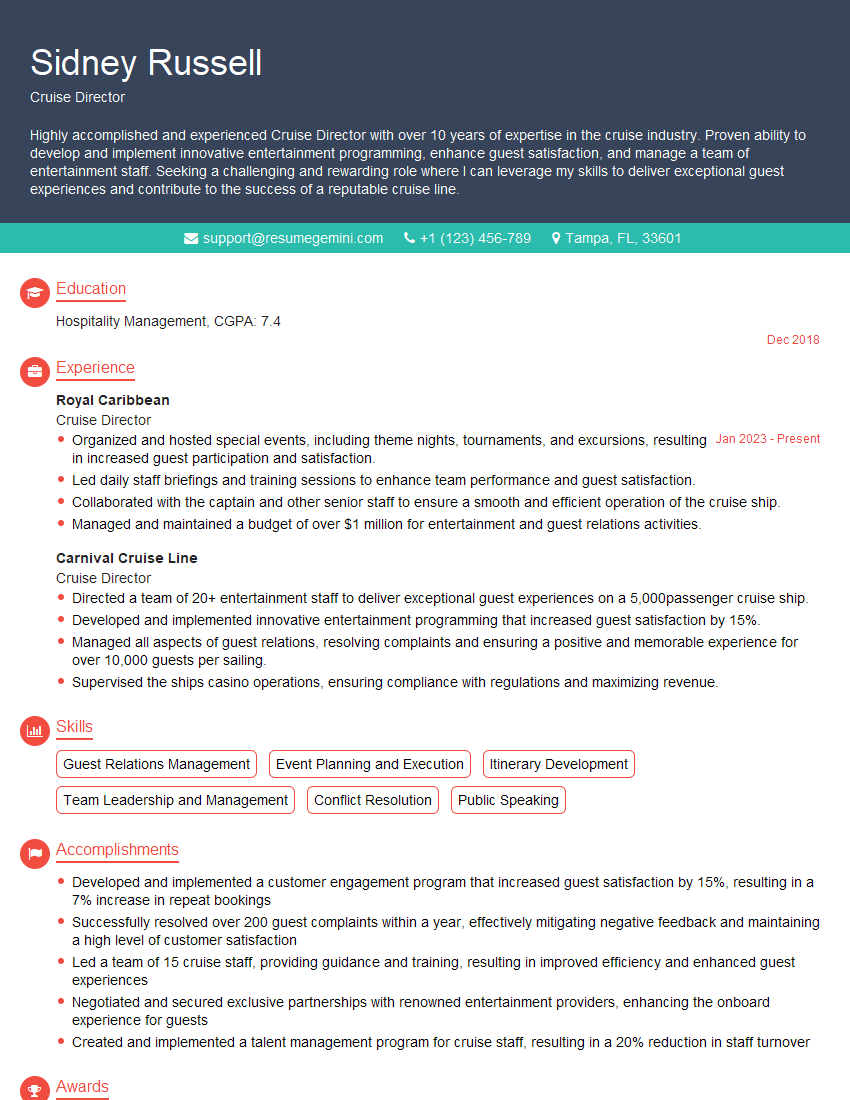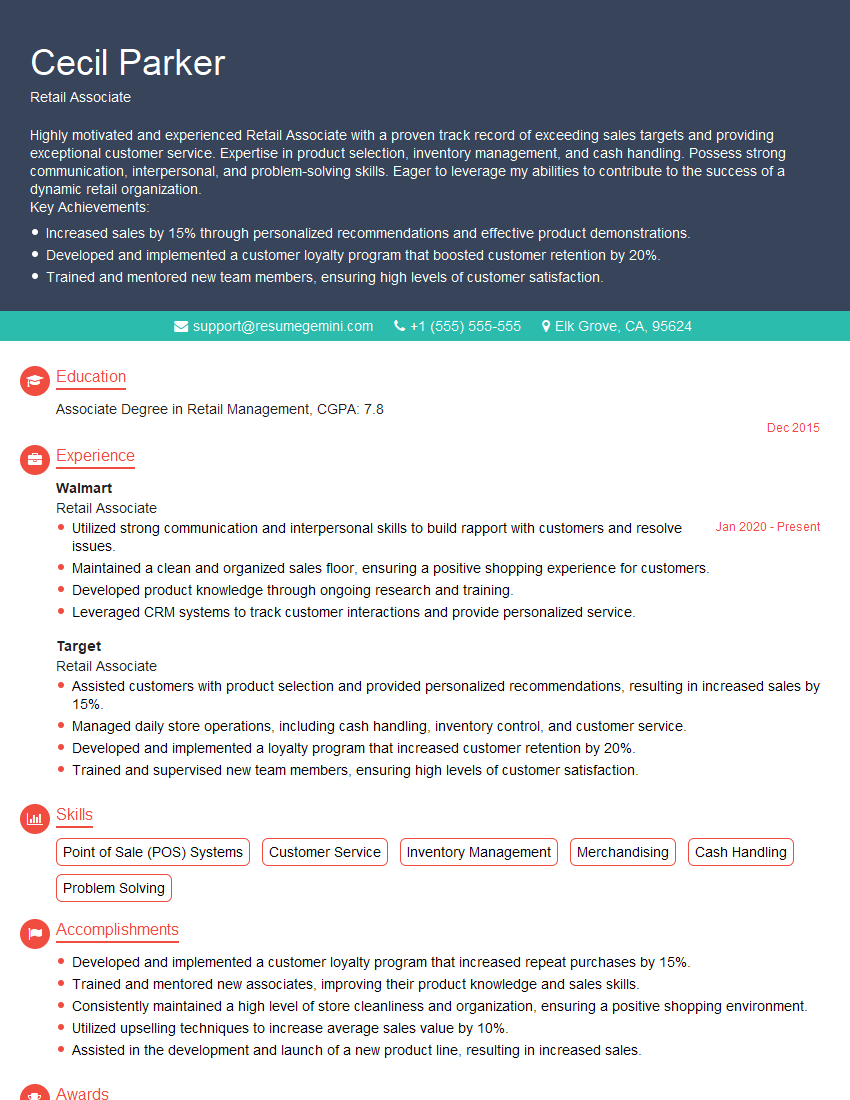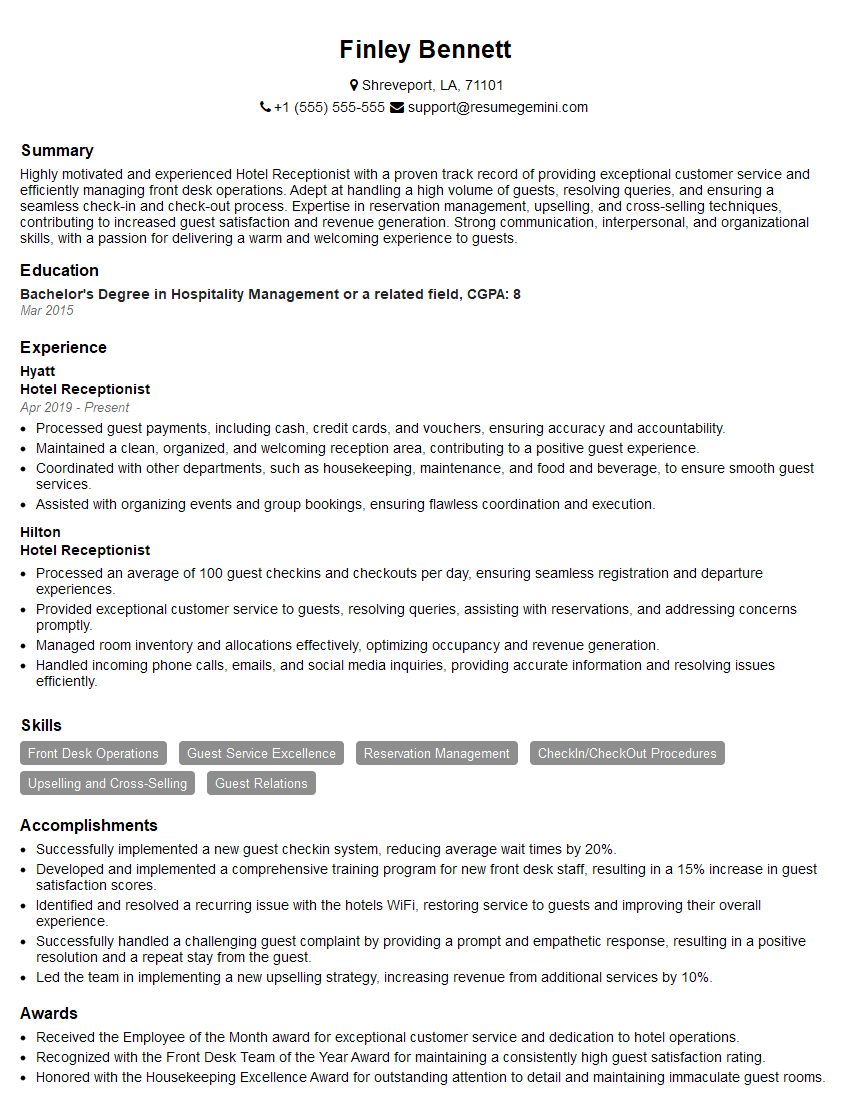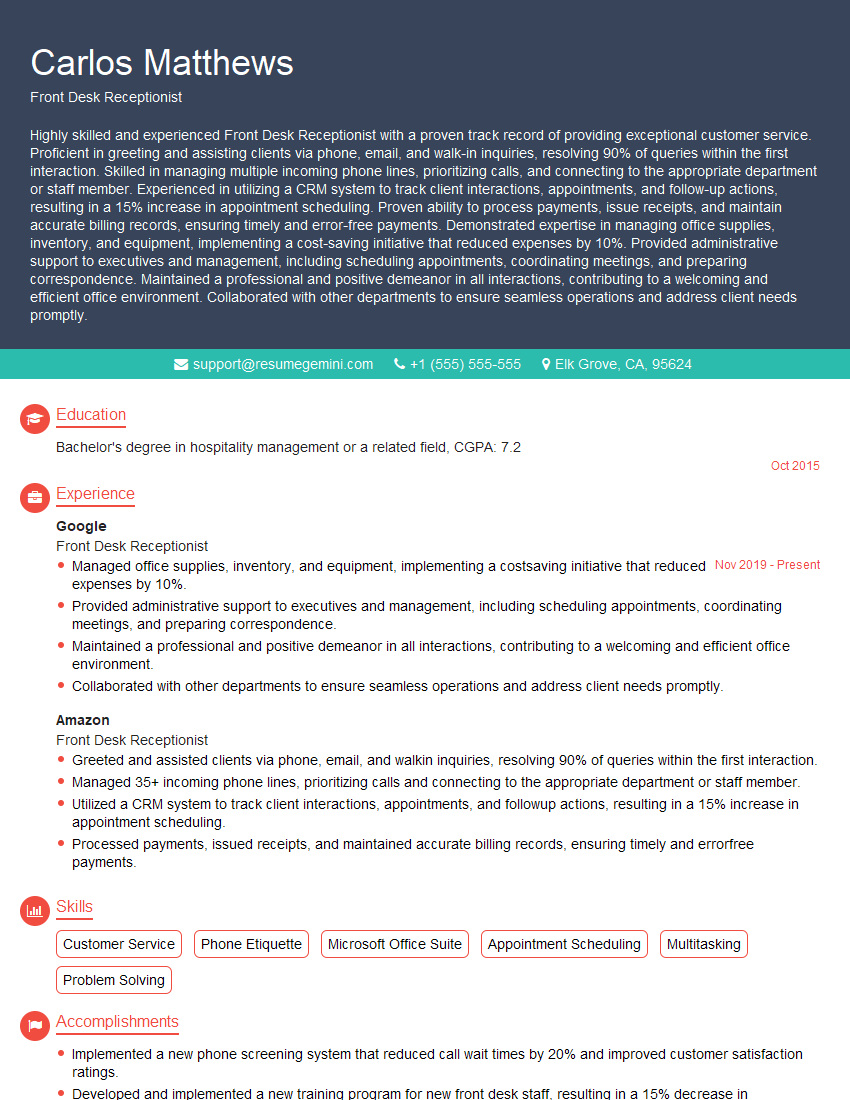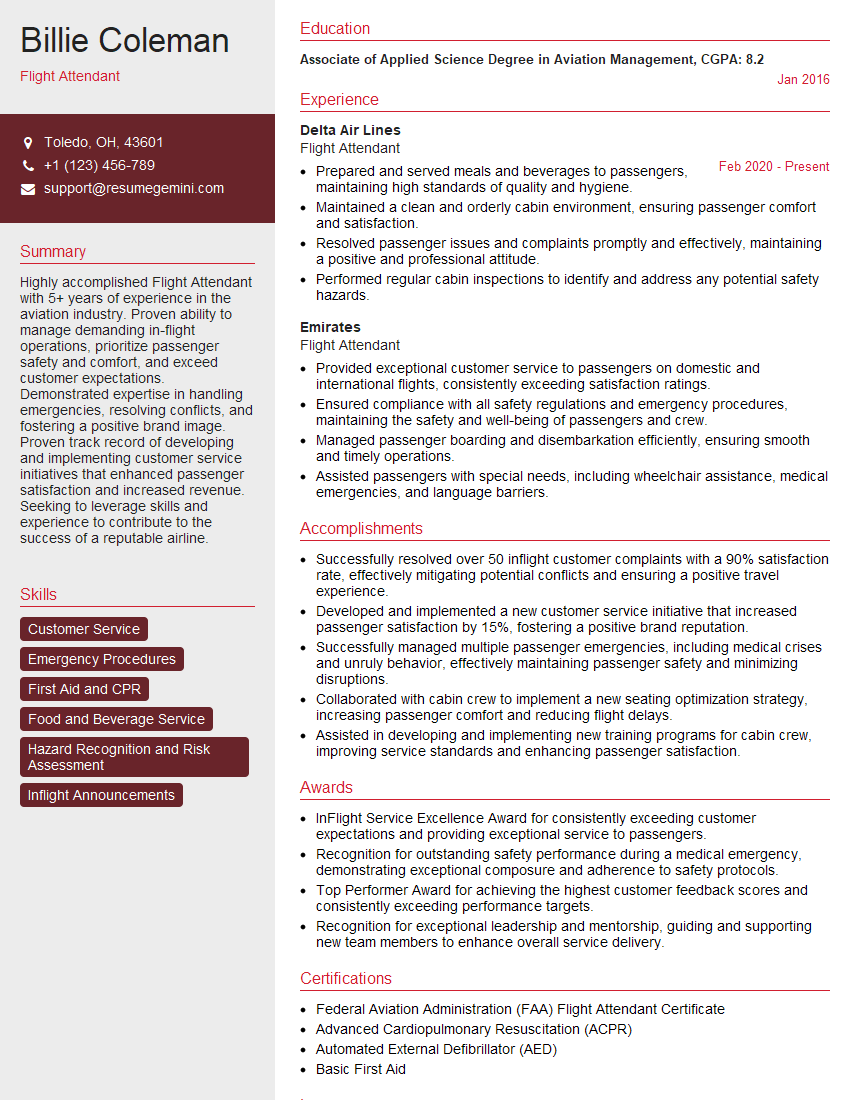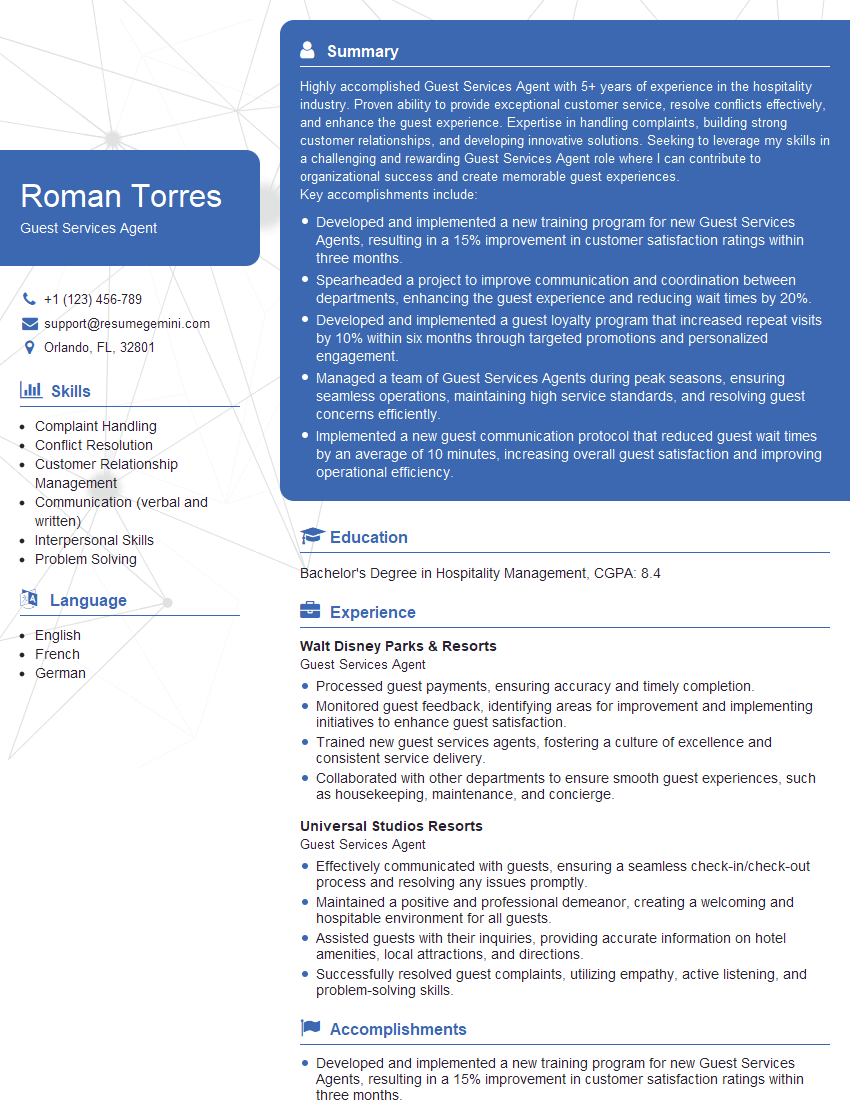The right preparation can turn an interview into an opportunity to showcase your expertise. This guide to Greetings interview questions is your ultimate resource, providing key insights and tips to help you ace your responses and stand out as a top candidate.
Questions Asked in Greetings Interview
Q 1. What is the appropriate way to greet someone in a formal business setting?
In formal business settings, a firm handshake and direct eye contact are crucial. The greeting should be polite and professional. A simple “Good morning/afternoon/evening, [Name]”, followed by a brief, relevant comment, is ideal. For example, “Good morning, Mr. Jones, it’s a pleasure to meet you.” or “Good afternoon, Ms. Smith, thank you for taking the time to meet with me.” Avoid overly familiar greetings or slang. Remember to let the other person initiate the handshake. If you’re unsure of the pronunciation of someone’s name, politely ask for clarification.
Example: Instead of ‘Hey, how’s it going?’, opt for ‘Good morning, Mr. Lee. I hope you’re having a productive day.’
Q 2. How do you adapt your greeting to different cultural backgrounds?
Adapting greetings to different cultures requires sensitivity and awareness. Researching common customs beforehand is vital. For instance, in some cultures, bowing is more common than handshakes, while in others, prolonged eye contact might be considered disrespectful. In some cultures, using the person’s title (Mr., Mrs., Dr.) is very important, while in others, using first names is perfectly acceptable, even in professional settings. Observe how others are greeting each other in the specific cultural context, and mirror their behavior as much as possible.
Example: In Japan, a slight bow is usually appropriate, while in many Latin American countries, a kiss on the cheek might be customary. Always err on the side of caution and be observant. When in doubt, a simple ‘Hello’ or ‘Good morning’ combined with a smile and a respectful nod is a safe and universally understood approach.
Q 3. Describe your approach to greeting a diverse group of people.
When greeting a diverse group, I prioritize inclusivity. I start by addressing the entire group with a general greeting like, “Good morning, everyone.” Then, I make an effort to make eye contact with and individually acknowledge as many people as possible. This shows respect and ensures no one feels overlooked. If possible, I try to learn a few basic greetings in the languages spoken by members of the group, demonstrating cultural sensitivity and appreciation. The most important aspect is to create a welcoming and comfortable atmosphere for everyone.
Example: In a meeting with colleagues from different backgrounds, I would say “Good morning, everyone. It’s wonderful to see you all here today.” Then I would make an effort to address each person individually and use their preferred names.
Q 4. How do you handle a situation where someone doesn’t respond to your greeting?
If someone doesn’t respond to my greeting, I don’t take it personally. I might offer a slight nod or smile and move on. There could be many reasons for a lack of response – they may be preoccupied, shy, or perhaps didn’t hear me. I wouldn’t repeat the greeting insistently, as this could be perceived as intrusive. In a professional setting, I might address them again later in a conversation or meeting, starting with a different approach.
Example: If someone doesn’t respond to my “Good morning,” I might simply smile and continue on with my tasks. If necessary, I could try a more direct approach later, such as “Excuse me, [Name], I wanted to chat with you about…”.
Q 5. What is the importance of making eye contact when greeting someone?
Eye contact is crucial for establishing a connection and showing respect. It demonstrates confidence, sincerity, and attentiveness. In many cultures, avoiding eye contact can be interpreted as disinterest, disrespect, or dishonesty. However, it’s important to be mindful of cultural norms, as direct eye contact can be inappropriate in some cultures. The key is to find a comfortable balance that shows engagement without being intrusive. Maintaining eye contact for a brief period during the greeting, and then shifting naturally as the conversation progresses is a generally good strategy.
Example: Briefly making eye contact when shaking hands and during the initial greeting shows you are engaged and interested in the interaction. However, maintaining intense, unwavering eye contact throughout an entire conversation could be perceived as aggressive or intimidating.
Q 6. How would you greet a potential client on the phone?
When greeting a potential client on the phone, professionalism and enthusiasm are key. I would start with a warm and confident greeting, such as: “Good morning/afternoon, this is [Your Name] from [Your Company]. Thank you for calling.” I would then briefly identify the purpose of my call. The tone of my voice should be friendly and inviting but also convey competence and credibility.
Example: “Good morning, this is Sarah Miller from Green Solutions. Thank you for calling. I’m calling to follow up on our previous conversation regarding your solar energy needs.”
Q 7. How would you greet a superior in person?
Greeting a superior in person requires respect and professionalism. I would use a formal greeting such as “Good morning/afternoon, [Superior’s Title] [Superior’s Last Name]” and maintain appropriate eye contact and body language. My demeanor should reflect respect and attentiveness. Depending on the context, a brief and polite comment may be appropriate, like “Good morning, Mr. Anderson, I hope you’re having a productive day.” Avoid casual greetings or nicknames. Remember to allow them to initiate any physical contact, like a handshake.
Example: Instead of a casual ‘Hi, boss’, use a respectful greeting like ‘Good morning, Mr. Davies. I hope you’re having a good start to your day.’
Q 8. How do you introduce yourself in a professional setting?
Introducing yourself professionally involves a balance of formality and approachability. It’s about making a positive first impression while conveying confidence and competence.
A strong introduction typically includes:
- A warm greeting: Start with a simple “Hello” or “Good morning/afternoon.”
- Your name: Clearly state your full name, ensuring it’s easily understood. For example, “Hello, my name is Sarah Chen.”
- Your title/role (if applicable): This provides context. For instance, “Hello, my name is Sarah Chen, and I’m a Senior Project Manager at Acme Corp.”
- Optional: brief, relevant context (if appropriate): Only include this if it’s directly relevant to the situation. For example, if attending a networking event, you might add, “…and I’m interested in learning more about sustainable business practices.”
Remember to maintain eye contact, offer a firm handshake (when appropriate), and smile warmly. Practicing your introduction beforehand can boost your confidence and ensure a smooth delivery.
Q 9. What verbal and nonverbal cues indicate a positive greeting?
Positive greetings involve a blend of verbal and nonverbal cues working in harmony. Think of it like a well-orchestrated performance!
Verbal cues:
- Warm tone of voice: Avoid monotone speech; let your enthusiasm shine through.
- Positive language: Use words like “great,” “pleased,” or “wonderful” to establish a positive atmosphere.
- Personalized greeting: If you know the person, use their name. If not, a friendly “Hello” is a safe bet.
- Enthusiasm: Show genuine interest in the interaction.
Nonverbal cues:
- Smiling: A genuine smile is contagious and instantly creates warmth.
- Eye contact: Maintain appropriate eye contact to show engagement and respect (but avoid staring).
- Open posture: Uncross your arms and maintain a relaxed yet attentive stance.
- Appropriate body language: A firm handshake (when culturally appropriate), a slight nod, or a welcoming gesture can further enhance the interaction.
- Appropriate personal space: Maintain a comfortable distance to avoid making the other person feel uncomfortable.
The key is congruence – your verbal and nonverbal cues should align to create a genuine and positive impression.
Q 10. Explain the difference between a formal and informal greeting.
The difference between formal and informal greetings lies in the level of formality and the context of the interaction.
Formal greetings are typically used in professional settings, with clients, superiors, or individuals you don’t know well. They emphasize respect and professionalism. Examples include:
- “Good morning, Mr./Ms./Dr. [Last Name]”
- “It’s a pleasure to meet you.”
- “How do you do?” (a more traditional formal greeting)
Informal greetings are used among friends, colleagues you know well, or in casual settings. They are more relaxed and friendly. Examples include:
- “Hi [First Name]”
- “Hey [Nick Name]”
- “What’s up?”
- “How’s it going?”
Choosing the appropriate level of formality depends on the situation, your relationship with the person, and the cultural norms of the environment. Using an overly formal greeting in a casual setting can feel stiff, while using an informal greeting in a formal setting can be perceived as unprofessional.
Q 11. How do you handle greeting someone who is already engaged in a conversation?
When someone is already engaged in a conversation, it’s crucial to be respectful and avoid interrupting. A thoughtful approach is key.
Steps to take:
- Wait for a natural pause: Observe the conversation and wait for a lull or a natural break before approaching.
- Get their attention politely: A gentle cough, a brief “Excuse me,” or a simple wave might suffice.
- State your purpose briefly: Keep your initial interaction short and to the point. For instance, “Excuse me, I just wanted to quickly ask you about…”
- Be mindful of their time: Respect their engagement and avoid prolonged interaction.
- Offer to continue later: If your request needs more than a quick answer, offer to speak at a more opportune time. For example, “Would you mind if I spoke to you briefly later about this?”
By showing consideration for their current conversation, you demonstrate respect and enhance your professional image.
Q 12. How do you remember names and use them appropriately in greetings?
Remembering names is a valuable social skill that improves interactions. Here are some strategies:
During introduction:
- Repeat the name: When introduced, repeat the person’s name immediately. For example, “It’s a pleasure to meet you, David.”
- Associate the name with a visual detail: Try to connect the name with a memorable feature, such as their appearance or attire. Think: “David with the striking blue tie.”
- Use the name in conversation: Use the person’s name naturally in conversation, but don’t overdo it.
After the introduction:
- Write it down: Discreetly jot down the name with a brief note (e.g., “David – marketing manager”) if appropriate.
- Review your notes: Review your notes soon after the meeting to reinforce memory.
- Utilize technology: Consider using a contact management tool or app.
Using names appropriately:
- Use the preferred name: Always use the name the person prefers (e.g., some may prefer to go by a nickname).
- Match the formality: Use formal names (Mr./Ms./Dr. Last Name) in formal settings and first names in informal ones.
- Pronunciation: If unsure of the pronunciation, politely ask, “How do you pronounce your name?” It shows respect and attentiveness.
Q 13. What is the appropriate distance to maintain when greeting someone?
The appropriate distance to maintain when greeting someone depends on your relationship with them and the cultural context. This concept is known as proxemics.
General guidelines:
- Intimate distance (0-18 inches): Reserved for close relationships, like family and intimate partners. Not appropriate for professional greetings.
- Personal distance (18 inches – 4 feet): Suitable for conversations with friends, colleagues, and acquaintances. Generally appropriate for many professional greetings.
- Social distance (4-12 feet): Used for more formal interactions, such as presentations or public speaking.
- Public distance (12 feet and beyond): Used for interactions with strangers or in large public gatherings.
Cultural variations: Personal space preferences vary across cultures. Some cultures are more comfortable with closer proximity, while others prefer more distance. Observe the person’s body language and adjust accordingly. If in doubt, err on the side of maintaining a slightly greater distance. Be mindful and respectful of cultural norms.
Q 14. How do you tailor your greeting to the specific context (e.g., meeting, email, phone)?
Tailoring your greeting to the context ensures professionalism and appropriateness. Here’s how to approach different situations:
Meeting:
- In-person: Use a formal greeting, like “Good morning, it’s a pleasure to meet you.” Offer a firm handshake.
- Video conferencing: A warm greeting acknowledging the meeting, such as “Hello everyone, thanks for joining.” is fitting.
Email:
- Formal: Use a formal salutation, such as “Dear Mr./Ms./Dr. [Last Name]” and a professional closing like “Sincerely.”
- Informal: Use a less formal greeting, such as “Hi [First Name]” if your relationship allows for it.
Phone:
- Formal: Identify yourself clearly and your purpose, “Good morning, this is Sarah Chen from Acme Corp. calling regarding…”
- Informal: Use a friendly greeting if appropriate given your relationship.
Key takeaway: Always consider the context, your relationship with the recipient, and the overall tone you wish to convey. A well-crafted greeting sets the stage for a successful interaction, regardless of the communication channel.
Q 15. How do you handle a greeting in a high-pressure situation (e.g., during an emergency)?
In high-pressure situations, efficiency and clarity are paramount. Your greeting needs to be brief, reassuring, and focused on the immediate task. Forget elaborate pleasantries; instead, prioritize conveying competence and control.
For example, in a medical emergency, a simple, direct greeting like “I’m Dr. Smith, I’m here to help” is far more effective than a lengthy, friendly introduction. The focus is on establishing authority and providing immediate reassurance to the patient and their family. In a business context, during a crisis meeting, “Good morning, team. Let’s focus on resolving this issue quickly.” is more suitable than general small talk.
The key is to convey calmness and competence through a concise, confident greeting tailored to the severity of the emergency. Avoid overly casual greetings or lengthy explanations that might waste precious time.
Career Expert Tips:
- Ace those interviews! Prepare effectively by reviewing the Top 50 Most Common Interview Questions on ResumeGemini.
- Navigate your job search with confidence! Explore a wide range of Career Tips on ResumeGemini. Learn about common challenges and recommendations to overcome them.
- Craft the perfect resume! Master the Art of Resume Writing with ResumeGemini’s guide. Showcase your unique qualifications and achievements effectively.
- Don’t miss out on holiday savings! Build your dream resume with ResumeGemini’s ATS optimized templates.
Q 16. What is your strategy for greeting multiple people simultaneously?
Greeting multiple people simultaneously requires a strategic approach that balances personalization with efficiency. A broad, inclusive greeting followed by individual acknowledgements works well.
For instance, you might start with: “Good morning, everyone!” then quickly move to more personalized interactions: “Sarah, great to see you,” or, “John, how’s the project progressing?” This combines a general welcome with individual attention, making everyone feel acknowledged.
In larger groups, consider using visual cues like nodding and smiling to individuals while addressing the group as a whole. The aim is to create a sense of inclusion while ensuring no one feels overlooked. Using names, where possible, makes the interaction more personal and memorable.
Q 17. How do you make a positive first impression through your greeting?
A positive first impression hinges on a greeting that is warm, confident, and appropriate to the context. It’s a combination of verbal and nonverbal cues.
- Warmth: A genuine smile, appropriate eye contact, and a friendly tone of voice instantly create a welcoming atmosphere.
- Confidence: Speak clearly and confidently, avoid mumbling or apologizing unnecessarily. Your posture and body language should reflect self-assurance.
- Appropriateness: Tailor your greeting to the situation and the individual. A casual “Hey” might be suitable amongst friends, but a formal “Good morning, Mr./Ms. [Last Name]” is more appropriate in a professional setting.
For example, imagine meeting a potential client. A confident “Good morning, Mr. Jones, it’s a pleasure to finally meet you,” coupled with a firm handshake and a genuine smile sets a professional and positive tone for the interaction.
Q 18. Describe a time when your greeting had a positive impact on an interaction.
During a particularly stressful project deadline, our team was experiencing significant tension. I started each morning with a brief, positive greeting, acknowledging the pressure but highlighting our shared goal and team spirit.
Instead of focusing on the challenges, I’d say something like: “Good morning, team! Big day today, but I know we can pull this off together. Let’s keep focused and support each other.” This small gesture shifted the atmosphere from tense negativity to collaborative positivity. It improved team morale, fostering a more productive and supportive environment that ultimately led to the successful completion of the project on time.
Q 19. What techniques do you use to build rapport through your greeting?
Building rapport through greetings involves going beyond a simple acknowledgment. It requires actively engaging the other person and showing genuine interest.
- Active Listening: Pay attention to their response and show interest in what they have to say. This goes beyond simply hearing their words; it involves understanding the sentiment and context.
- Personalized touches: If you know something about the person (e.g., a recent accomplishment or a shared interest), incorporating it into your greeting can create an instant connection.
- Mirroring (subtly): Matching their body language or tone (not mimicking, but mirroring) can create a sense of subconscious connection and rapport.
For example, if someone mentions a successful presentation in your greeting, you could say, “I heard your presentation was fantastic – congratulations!” This demonstrates active listening and builds rapport by showing genuine interest in their success.
Q 20. How do you deal with a negative or unresponsive greeting from another person?
Dealing with a negative or unresponsive greeting requires tact and emotional intelligence. Avoid mirroring negativity; instead, aim to de-escalate the situation.
- Acknowledge their response: Don’t ignore their lack of enthusiasm; you might say something like, “I understand you might be having a busy day.” This acknowledges their behavior without being accusatory.
- Offer a positive response: Maintain a professional and friendly demeanor, focusing on positive aspects. For example, “Regardless, I’m happy to assist you.”
- Re-engage later (if appropriate): If the interaction isn’t urgent, try to re-engage later when they might be more receptive.
Remember, a negative response is often a reflection of the other person’s state, not a personal attack. Your calm and professional response can help to diffuse the tension.
Q 21. Describe your understanding of different communication styles and how they affect greetings.
Understanding communication styles is crucial for effective greetings. Different styles influence the type of greeting that will be most effective and well-received.
- Direct Communicators: Prefer clear, concise greetings. A straightforward “Good morning, let’s get started” is appropriate.
- Indirect Communicators: Might prefer a more nuanced approach, starting with small talk before getting to the main point. A casual “How’s your day going?” followed by the work-related greeting might be better.
- Expressive Communicators: Respond well to enthusiastic, warm greetings. A lively “Hi there! Great to see you!” will be well-received.
- Reserved Communicators: Prefer more subtle greetings. A simple nod and “Good morning” might suffice.
Adapting your greeting style to the other person’s communication preferences shows respect and understanding, fostering better communication and a stronger rapport from the start.
Q 22. How can greetings contribute to a positive and productive working environment?
A warm and appropriate greeting sets the tone for any interaction, significantly impacting workplace dynamics. In a professional setting, a simple “Good morning” or “Hello” can foster a positive and productive environment by establishing rapport, demonstrating respect, and promoting a sense of community. This seemingly small gesture reduces communication barriers and creates a welcoming atmosphere.
- Improved Communication: A friendly greeting encourages open communication and collaboration. People are more likely to approach and engage with colleagues they feel comfortable with.
- Increased Morale: Being acknowledged and greeted positively contributes to a sense of belonging and boosts employee morale, leading to greater job satisfaction.
- Enhanced Productivity: A positive work environment, fostered by respectful greetings, reduces stress and improves focus, ultimately leading to increased productivity.
- Stronger Teamwork: Regular, positive greetings help build strong relationships between colleagues and enhance team cohesion.
Think of it like this: imagine walking into a meeting where everyone ignores you. Compared to a room where people greet you warmly, the second scenario instantly makes you feel more welcome and prepared to contribute.
Q 23. What are some common mistakes to avoid when greeting people professionally?
Common mistakes in professional greetings often stem from insensitivity, lack of awareness, or poor etiquette. Avoiding these pitfalls is crucial for maintaining professional relationships.
- Ignoring people: This is arguably the most significant mistake, conveying dismissiveness and rudeness. Always acknowledge the presence of others, even if you’re busy.
- Inappropriate informality: While friendliness is important, overly casual greetings (like nicknames without permission) can be inappropriate in formal settings.
- Ignoring titles or using incorrect ones: Respecting people’s titles (Dr., Mr., Ms., etc.) demonstrates professionalism and consideration. Incorrect use can be offensive.
- Distracted greetings: Giving a half-hearted, rushed greeting suggests disinterest and lack of respect. Give your full attention to the person you are greeting.
- Overly familiar greetings: Avoid physical contact (like hugs or pats on the back) unless you know the person well and are certain it’s appropriate within the workplace culture.
- Using inappropriate language or slang: Professional greetings should use clear, respectful language suitable for the workplace.
Q 24. How can you adapt your greeting to the recipient’s personality?
Adapting your greeting to the recipient’s personality requires observation and sensitivity. While a firm handshake and formal greeting might be suitable for a senior executive, a warm smile and friendly “Hi” might be more appropriate for a younger colleague you’ve built rapport with. Consider these factors:
- Personality: Is the person generally reserved or outgoing? Formal or informal?
- Relationship: How well do you know this person? Is it a casual or formal relationship?
- Context: Is it a formal meeting or a casual hallway encounter?
For example, I might greet a reserved colleague with a simple, respectful “Good morning, Mr. Jones,” while I might greet a close colleague with a friendly “Hey Sarah, how’s your day going?” The key is to gauge the individual’s preference and adjust your approach accordingly.
Q 25. How do you ensure your greeting is inclusive and respectful to all individuals?
Inclusive and respectful greetings acknowledge the diversity of individuals and avoid making assumptions or using language that could be exclusionary. This involves:
- Using inclusive language: Avoid gendered terms or assumptions about someone’s identity or background.
- Pronoun awareness: If unsure of someone’s pronouns, it’s best to avoid using pronouns altogether or ask politely.
- Cultural sensitivity: Be mindful of cultural differences in greetings. What is appropriate in one culture might be inappropriate in another.
- Addressing individuals directly: Use someone’s preferred name, and avoid using nicknames or terms of endearment unless explicitly invited to do so.
- Accessibility Considerations: Adapt your greeting to accommodate individuals with disabilities. For instance, ensure good eye contact with someone who is visually impaired.
Remember, being inclusive is about demonstrating respect and creating a welcoming space for everyone. A simple “Good morning” or “Hello” goes a long way in showing that you value and appreciate all individuals.
Q 26. How do you practice and improve your greeting skills?
Improving greeting skills is an ongoing process. Consider these practices:
- Observe others: Pay attention to how skilled communicators greet people. Note their tone, body language, and word choice.
- Practice in various settings: Actively practice greeting people in different contexts – with colleagues, clients, and superiors. This builds confidence and flexibility.
- Seek feedback: Ask trusted colleagues or mentors for feedback on your greeting style. Their insights can be invaluable.
- Self-reflection: After each interaction, reflect on how you could have improved your greeting. Were you too formal, too informal, or unclear?
- Role-playing: Practice greeting different personality types in a role-playing setting to develop your adaptability and comfort level.
Consistency is key. The more you practice and reflect, the more natural and effective your greetings will become.
Q 27. Describe a situation where you had to modify your greeting due to unforeseen circumstances.
I once had to modify my greeting due to an unexpected emergency. I was about to give a formal presentation when a fire alarm went off. Instead of my planned upbeat introduction, I calmly and clearly announced, “Everyone, please remain calm and follow the evacuation procedures.” This prioritized safety and adjusted the interaction to suit the urgent circumstances. My standard enthusiastic greeting was inappropriate for the emergency situation, so a direct, urgent message was far more effective.
Q 28. How would you handle a situation where you mispronounce someone’s name in a greeting?
Mispronouncing someone’s name is an easy mistake to make, but it’s important to handle it gracefully. I would immediately apologize, correct myself if possible, and then try to ensure I don’t repeat the mistake. For example, I might say, “I’m so sorry, I mispronounced your name. Could you please say it again for me?” Then, I’d repeat the name back correctly to show I’ve made an effort to learn it. I’d also take note of the correct pronunciation for future interactions to avoid further repetition. If I’m still unsure after trying this process, I would ask politely for assistance.
Key Topics to Learn for Greetings Interview
- Verbal Greetings: Understanding cultural nuances and appropriate greetings in various professional settings. Practical application includes analyzing context and choosing the most effective greeting for a given situation.
- Written Greetings: Mastering the art of professional email and letter writing, including salutations, closings, and tone. Practical application includes composing effective emails for different purposes (e.g., networking, follow-up).
- Nonverbal Greetings: The significance of body language, eye contact, and personal space in making a positive first impression. Practical application involves self-assessment and improvement of nonverbal communication skills.
- First Impressions: The impact of greetings on establishing rapport and setting the tone for future interactions. Practical application includes role-playing and receiving feedback on greeting techniques.
- Technology and Greetings: Integrating appropriate greetings in phone calls, video conferencing, and other digital communication platforms. Practical application focuses on adapting communication styles to different technologies.
- Handling Difficult Greetings: Strategies for managing challenging situations, such as dealing with unexpected or inappropriate greetings. Problem-solving involves developing flexible responses and maintaining professionalism.
Next Steps
Mastering the art of greetings is crucial for career advancement. Effective greetings build strong professional relationships, demonstrate respect, and create a positive first impression—essential for success in any role. To significantly enhance your job prospects, focus on building an ATS-friendly resume that highlights your skills and experience in this area. ResumeGemini is a trusted resource that can help you craft a professional and impactful resume. Examples of resumes tailored to showcasing expertise in Greetings are provided below to help guide you. Use these examples as inspiration to create a compelling resume that gets you noticed!
Explore more articles
Users Rating of Our Blogs
Share Your Experience
We value your feedback! Please rate our content and share your thoughts (optional).
What Readers Say About Our Blog
Hello,
We found issues with your domain’s email setup that may be sending your messages to spam or blocking them completely. InboxShield Mini shows you how to fix it in minutes — no tech skills required.
Scan your domain now for details: https://inboxshield-mini.com/
— Adam @ InboxShield Mini
Reply STOP to unsubscribe
Hi, are you owner of interviewgemini.com? What if I told you I could help you find extra time in your schedule, reconnect with leads you didn’t even realize you missed, and bring in more “I want to work with you” conversations, without increasing your ad spend or hiring a full-time employee?
All with a flexible, budget-friendly service that could easily pay for itself. Sounds good?
Would it be nice to jump on a quick 10-minute call so I can show you exactly how we make this work?
Best,
Hapei
Marketing Director
Hey, I know you’re the owner of interviewgemini.com. I’ll be quick.
Fundraising for your business is tough and time-consuming. We make it easier by guaranteeing two private investor meetings each month, for six months. No demos, no pitch events – just direct introductions to active investors matched to your startup.
If youR17;re raising, this could help you build real momentum. Want me to send more info?
Hi, I represent an SEO company that specialises in getting you AI citations and higher rankings on Google. I’d like to offer you a 100% free SEO audit for your website. Would you be interested?
Hi, I represent an SEO company that specialises in getting you AI citations and higher rankings on Google. I’d like to offer you a 100% free SEO audit for your website. Would you be interested?
good





